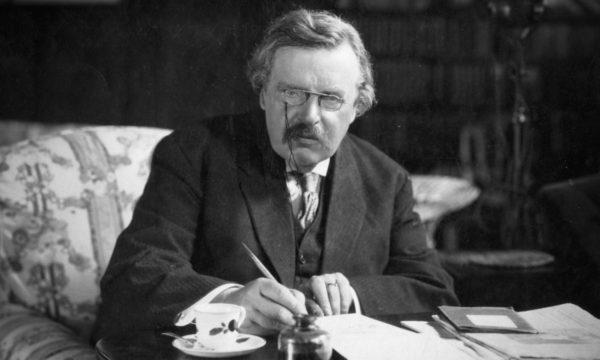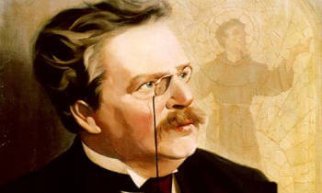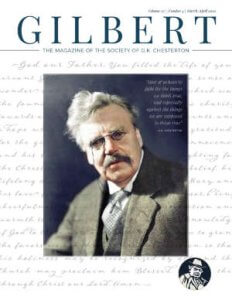Here is a scenario for a game of twenty questions: a man chases another man outside in a violent thunderstorm, lassoing him with a rope, dragging him like a sack, tying him to a tree, pinning his head to the trunk with the prongs of a pitchfork on either side of the neck, and then leaves him there in the rain. When the tied up fellow is finally released he goes looking for the other man in order to thank him. Why?
Or another question might be: which is the poet and which is the lunatic?
Don’t look for the answer here. Read “The Crime of Gabriel Gale” in Chesterton’s The Poet and the Lunatics, a collection of eight mysteries involving a poet/detective named Gabriel. No, not that Gabriel. A different one. Someday someone will do a doctoral thesis comparing Gabriel Syme of The Man Who Was Thursday with Gabriel Gale of this book. It will mean Chesterton will finally be taken seriously. Too seriously.
That dissertation, which I hope I never have to read, would be remiss not to mention the ongoing theme, or battle rather, between sanity and lunacy in Chesterton’s writings. In Orthodoxy, he makes the startling statement that the madman is not the man who has lost his reason, but the man who has lost everything except his reason. The tales in The Poet and the Lunatics illustrate this point. They are detective stories where the criminal has succumbed to some form of madness, and the detective who solves the crimes seems to be fighting off madness himself. The sleuth is Gabriel Gale, who is also a poet and an artist. His reason is must always be balanced by his creative imagination. Good art is all about balance and proper proportion. But sanity, too, is a balancing act. We are all walking on a tightrope stretched over an abyss, and it is surprisingly easy to lean too far in one direction or the other. We often pursue ideas that seem perfectly reasonable, and are perfectly reasonable, but their perfection is a trap. Freedom, for instance, is good, but a man who wants to free everything even from its natural limits, is not only insane but is a real danger to everyone else, as we discover in “The Yellow Bird.” Happiness is good, but we cannot be happy if we do not believe in evil, as we learn in “The House of the Peacock.”
Pure reason lacks paradox. It lacks the contradictory quality that makes us human. It lacks humor. As Gabriel Gale points out, the worst thing to do with people who are losing their sense of humor is to humor them. He confronts theorists with reality. He succeeds by being impractical.
As a pure detective story, “The Shadow of the Shark,” is one of Chesterton’s finest, where Gabriel Gale solves a sort of “locked room” murder mystery, with the amazing variation that the crime takes place on a beach! To add to the twists, the lunatic in this case is someone who denies that there are any mysteries.
This collection prompted one reviewer to remark that Chesterton invented a type of detective story “that only he could have devised and only he can successfully execute.” The reviewer called “theological detection.” But as another reviewer pointed out, the stories are “full of philosophic wisdom which is never an intrusion in his works, but a genuine, inseparable part of it.”
Chesterton certainly uses detective fiction for a higher purpose, but in his hands such a medium is ideally suited for that purpose. The lunatic is someone who loses his way and cannot return. The modern world is in the exact same predicament as the lunatic. Chesterton is trying to lead the world back to what is sane, what is normal. It is fitting that his most straightforward treatment of how to solve the complex problems in our society is called The Outline of Sanity. A point which no doubt will be pounded to death in that future dissertation. As will the following point.
In one story Gabriel Gale says, “I doubt whether any truth can be told except in a parable.” This profound line captures the essence of Kierkegaard’s Christian Existentialism, which Chesterton happily never encountered. There is no straight line to Truth. Faith is a necessary condition for realizing and embracing the Truth. Faith must always supplement reason.
Among the truths told in the parables in this book are these:
1. The main object of life is to see things as we have never seen them before.
2. Liberty is the power of a thing to be itself.
3. The purpose of travel is to get home.
4. Everything has a halo.
Sane ideas, indeed. And beautiful.





